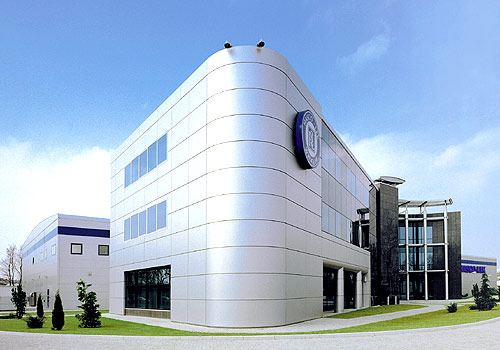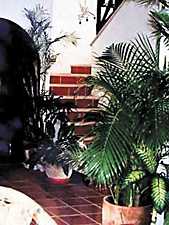VASTU SHASTRA
Vastu For Factory
Industrial Structures
Industrial structures need special attention in Vaastu analysis. In an industrial environment, the human potential is exploited to it's maximum in multidisciplinary activities - production clubbed with leadership function, research activity clubbed with market dynamics, achieving impedance-free movement of men and materials in crowded workplace etc.... This balancing act needs a perfect understanding of contribution of each of the Vaastu directions to the overall industrial space.

The Indian insight into Vastu planning is based on the concept of energy helix. This permits analysis of each part of the structure at individual level and then synthesizing these into the total structure. Vaastu shastra considers a Vaastu as a living being and as such, clubs the energetic of the Vaastu with various parameters to make it lively.
The character of a living entity is always reflected in its shape, form, size, and looks. Similarly, qualities like' harmony and rhythm are part of a symmetric structure. In industrial structures, the contribution of various directions is analysed on the basis of form and shape of structure, as well as the plot.
Considering the characteristics in an industrial structure, the following points can be noticed :-
North Light Structures
The concept of 'North Light Structure' has been borrowed from Europe where temperatures remain within 15 degrees Celsius throughout the year. But, in tropical countries like India, most of the time the sun remains in the southern zone. Even in the 'Uttarayan' (the winter solstice) the decline is hardly 10 degrees relative to the North. As such, the temperature differentials during the day exceed 15 to 30 degrees Celsius. In such a situation, projecting entire roof surface to the south to get northern light is an act of ignorance from environmental considerations. Due to high thermal absorption, such types of roofs disturb the entire electromagnetic field aligned with the structure. As per Vastu science, these structures tend to capture what is known as 'South Rhythm'. Case studies reveal that industrial units with these types of roofs suffer from low productivity and poor growth. All such structures need critical changes for achieving qualitative environmental enrichment.
North-South Length
If the North-South length of the industrial workshop is substantially larger than the East-West breadth, perimeter projected to solar radiation is minimized and results in cool healthy environment. Vaastushastra maintains that all the activities follow an ordered and disciplined pattern if the North-South axis is greater than the East-West axis.
Work Environment for Executives and Staff
Vaastushastra recommends that important executives should face the North direction with their sitting position in the Southwest zone. All the staff and workers should face East with their activity zone located in Central, Northern, or Eastern zones. From Vaastu energetic point of view, Southwest zone represents the highest point of the helix, and decisions taken in the confines of Southwest zone flow without friction to lower boundaries of the structure. The North-facing executives benefit from eternal flow and properly tuned psyche.
Zoning of Industrial Activities
In an industrial undertaking multiple activities are taking place simultaneously. To achieve better co-ordination and cohesion in these activities, it is desirable that specific operations are restricted to definite zones on the basis of involved energy levels.
Activity Zone
Research and development Northeast
Heavy loads and activity Southwest
Thermal activity Southeast
Finished products Northwest
Accounts and legal activity East zone
Chief Executive's cabin Southwest Zone (south side)
Toilets/Canteen/Retiring Room West zone
Landscaping and Loads
 Landscaping plays an important role in providing cosmic envelope to the Vaastu. Reshaping of a plot by landscaping is the simplest way to rectify the incorrect shapes and slopes in the plot. Remarkable improvement in the Vastu energetic results from the formation of external helix through load relocation in landscaping and planting of specific trees in landscaped gardens. In respiration process of the plants, rare gases are emitted, enriching the environment. This apart, the environment benefits from the plant biorhythm.
Landscaping plays an important role in providing cosmic envelope to the Vaastu. Reshaping of a plot by landscaping is the simplest way to rectify the incorrect shapes and slopes in the plot. Remarkable improvement in the Vastu energetic results from the formation of external helix through load relocation in landscaping and planting of specific trees in landscaped gardens. In respiration process of the plants, rare gases are emitted, enriching the environment. This apart, the environment benefits from the plant biorhythm.
If any digging or excavation has taken place in Southwest, Southeast, or Northwest zones for locating underground vessels or water tanks or septic tank, this source of negative energy should be compensated by material loading at landscape stage.
Exposed water-bodies in the North or Northeast zones are abundant sources of organic energy, as the sunlight is polarised in transverse direction by these water surfaces. The Northeast zone lies in the solar shadow region resulting in low thermal activity, which endows this zone with natural quality of harmony as far as electromagnetic energy is concerned. The same quality is transmitted along with the polarised organic energy from the North and Northeast zones.
To reduce the extended Southeast related ill effects in some plots, water body in the Southeast zone is sometimes advisable.
The Helix
It is said that life flows without friction and remains in natural rhythm if it is based on the logic of the 'Helix'. The helix form is followed right from the smallest virus to the gigantic 'Milky Way'. Most ancient scriptures refer to helix as the sacred curve. There are five different methods for implementing the 'helix' in a plot or a house, for effective Vaastushastra remedies.
- Rhythmic compound or boundary along a plot for linking solar stream qualities to the ground profile.
- Landscaping and locating loads to peripheral zones of the plot to redefine the relationship between the ground and the structure.
- Varying levels in plinths as per the load characteristics of the Vaastu-kshetra directions add to the vertical rhythm. The recommended pattern is as follows;
Northeast zone lowest level
Southeast zone level higher than NE zone
South zone higher than SE zone
Southwest zone higher than South zone
The helix in the plinth through this method can also be attained.
Pattern of flooring as per the requirements of the directions;
• Marble in the Northeast, North, or East zone reflects the photon energy and maintains the East and the North as source directions of positive energy.
• Agra red stone in the Southeast zone suits the thermal activity of the zone.
• Yellow Jaisalmer or Marble or Shahabad stone matches the Southwest zone characteristics, as yellow colour represents 'Prithvi-Tatwa', which has higher gravitational rhythm.
• Kota or Tandoor stone may be used in the Northwest zone.
Vaastu Analysis for an Industrial Unit General
Vaastu shastra is a science dealing with natural forces and energies, some directly experienced and some hidden. On the face of it, this discipline looks mysterious and ambiguous. But, all its rules and regulations can be traced to the basic sciences, particularly to the principles of physics pertaining to forces and energies.
Here we will present Vastu analysis for a typical industrial structure - buildings for a pharmaceutical manufacturing plant. For buildings housing medicine production facility, the concepts of quantum healing and energetic are of utmost importance. Vaastushastra has immense scope in such cases to provide virtuous bliss of Nature to the whole production set-up.
Multiple paths are available for improving any given Vastu situation. Here we are outlining the concepts and methodology involved in this process.
- At the site, it is possible to offset any asymmetry by variations in landscaping, if the plot is of odd non-regular geometric shape.
- By adjusting floor heights and plinths, it is possible to achieve harmony and rhythm suitable for the given ground profile.
- Influencing the virtues and qualities of Vastu directions as per the Vaastu-Purush-Mandal can compensate steep slopes in the ground terrain and odd shapes of the plot.
- Planting of specific trees suited for Vastu directions can diminish the bad effects of incorrect eddy gradients in the plot.
- Compound wall can be used to reshape the plot so as to achieve order and discipline in the site plans.
- Analysis of the energy-matter relationship can help in equalizing slopes in the ground.
- Landscaping and use of exposed water surfaces can attain cosmic helix in the building environment.
- By reorienting and adjusting doors, windows and openings, it is possible to minimize surface exposure to the sun.
- By blocking the energy flux through shadows and shades, the Jaivik electromagnetic flux can be enhanced to a certain degree.
Landscape Details
To achieve harmony with nature and bliss in the surrounding environment, it is essential that a definite shape is given to the plot and it is aligned properly with the geomagnetic axis. For the plot under study, the following measures are recommended as per Vaastu shastra;
- Provision of a heavy compound wall 24 inch thick and 7 ft high on Southwest zone, gradually reducing it to 18 inch thick and 5 ft high on Southeast side, and 9 inch thick - 3 ft high on the North and East sides. To match the shape, size, and periphery of 'Vaastu-kshetra' with the 'helix' pattern, these varying compound wall depths, widths, and heights are very useful. The helical alignment of compound wall balances the vices and virtues related to Vaastu directions and sub-directions.
- Provision of marble finish lunar shaped water-pool in the Northeast corner, having outside perimeter 20 ft, inside perimeter 15 ft, and depth 5 ft. Circular water-body with diameter 8 ft and depth 3 ft can also be provided. The exposed water surface in the Northeast polarises the solar rays in transverse direction and thus, creating a source for ordered Jaivik energy.
- Filling of pits in the Southwest, West, and South zones to attain ground slopes towards the North and East. This procedure offsets the energy-matter imbalance on account of heavy stress concentration in the Southwest zone. Elevating the Southwest zone in a Vaastu-kshetra reorients the cosmic energy flow to simulate a cosmic energy helix in the environment.
- The North and the East Side margins should be twice as much as those in the South and West.
- Provision of heavy 'Gurutwa' pedestal load in the Southwest corner of the plot. The aligned geomagnetic fields of a Vastu are disturbed due to high thermal activity in the Southwest zone. The disturbed energy fields can be balanced through heavy loads in this zone.
- Planting of trees around the periphery of the property based on 'Vruksha-Vichar'. Apart from the specific trees and plants indicated below, Audumber and Neem. trees are to be planted on South side to provide humid environment that aids in environmental enrichment through reduction in temperatures.
- West/Northwest zone is governed by the great element 'Vayu' and as such, planting of medicinal shrubs an Nilgiri on West gives aroma and bliss to entire Vastu.
- Main buildings should be placed in the Southwest zone an aligned in such a manner that North-South axis of building should match with the geomagnetic axis. The shape of the building should be rectangular.
- Bore-well should be provided in the Northeast comer.
- Septic tank should be located in the Northwest zone.
- Provision of pyramid-like structures made of organic matter like bamboo or wood over Southwest passages. The dimensions of the pyramid could be 8-ft X 8-ft base and 3 f height.
Internal Changes for the Vaastu
- Provision of 18-inch thick wall in the Southwest zone. The South and West zones are exposed to intense solar radiation due to the Sun's East to Southeast to Southwest to West sojourn through the sky. Thicker Southwest walls act as shields against intense heat and keep the internal building areas cool.
- Raising of the Southwest plinth by 6 inches. The Southwest zone is heavily loaded and or raised to compensate the imbalance in matter and energy due to heavy stress concentration.
- Provision of maximum possible openings or ventilators in the North and East to maintain balanced Pranik and Jaivik energy flow through the Vaastu.
- Arranging East-side entry for the workers and North-side entry for the proprietors and executives.
- Provision of additional floor in the Southwest zone. This helps in equalizing the disturbed matter and energy balance in this zone on account of stress concentration.
- Provision of slopes towards the North and the East. Sloping chajjas can be provided for this purpose.
- Provision of terraces in the North and East, with levels in these zones lower than the South and West zones, to satisfy the concept of helix formation through level shifting.
- Minimization of openings and ventilators in the South and West zones. If openings in these zones are unavoidable, then tilted bay windows can be provided for simulating sunlight entry from the North and East. It is to be noted that source of light in the South implies that Pranik energy is in mutual opposition with North-South geomagnetic flux lines, which is a source of Jaivik energy.
- Alignment of heavy machinery and heavy storage units in the South, Southwest, and West zones.
- Provision of flooring to obtain the helix effect.
Northeast White Marble
Southwest Yellow Shahabad / Jaisalmer
Southeast Pink or Red Agra
Northwest Kota Stone
Southwest YellowSoutheast Pink or Red
Northeast Glossy White
Northwest Mat Finish Blue or Green
 Painting scheme as per the well defined 'Ranga-Shastra' principles in Vaastu science. The colour variation based on five great elements and horoscope helps in attaining helix Format in a Vastu.
Painting scheme as per the well defined 'Ranga-Shastra' principles in Vaastu science. The colour variation based on five great elements and horoscope helps in attaining helix Format in a Vastu.
- Placing of all light fittings and electrical points on the North and East sides.
The analytical approach adopted here has benefited the pharmaceutical unit immensely; in management-workers relationship and in smooth running of the plant at optimum levels. Taking recourse to Vastu principles at planning stage has distinct advantages - smooth progress of work and salubrious working conditions.
For industries too, the selection of site is very important. Besides the fact that sufficient water and electricity should be available, the vastu of the plot, plot such as the shape of the plot, the roads facing the plots and the ground levels inside and outside the site are very important points that are to be observed.
The various principles of Vastu, which aid in setting up an industry, are as follows.
- Main roads towards east, north or north-east are advisable with wide gates on two sides.
- Gates in north-east or east or north or north-west are recommended
- Guard room should be either on north-west side of north gate of southeast side of east-gate.
- Minimum space should be kept in south and west where big trees could be grown. More open space should be left in north and east where lawns and other greenery can be grown.
- The floor levels in south-west must be higher than other sides and height of the building also must be higher than all the other corners. Care has to be taken to have the store rooms in south-west fully loaded with stocks to the extent possible As and when the stocks are consumed they should be replaced immediately.
- Car parking may be provided in north-west if open area is available. For light vehicles north east also could be used.
- Administrative Officers are to be located either in north or east, away from boundary walls with less height than the main factory. Here special care has to be taken in keeping north east corner open.
- Staff quarters may be constructed in south-east and north-west. If quarters are multi-storied and if the height is more than that of main factory, they should be constructed in south-west without touching the main premises.
- Toilets should be placed in north-west or south-eastern part of the buildings, and not in north-east or south-west.
- Wells, bore wells, water sumps and water ponds etc... should be in the north-eastern area.
- Over head tanks may be erected in west and nearby, duly maintaining the heights. South-west and north-east sides including north and east should be avoided, for constructing overhead tanks. This is a bit controversial subject and hence one should be very careful in locating the overhead tanks and also the water tanks above the ground level.
- Heavy machinery has to be installed in south, west or south-west in the factory.
- Raw materials storage, whether inside factory or sheds outside, should be in south or west or south-west.
- Products under process or unfinished goods may be kept in west direction.
- Finished products are to be kept in the north-west corner. It will help for quick movement of the stocks.
- Weighing machine may be located near the gate either in north or east because that area is not subjected to permanent weight. Transformers, generators, motors, boilers, furnaces, oil engines should be kept in south-east or close to south-east.
DAIRY PLANT
- Store the plastic bags in the south.
- Boiler and other instruments that involve exchange of heat must be installed in the south-west corner or in the south.
- Packing machine must be installed in the north or in the north-west corner.
- Store the packed milk in the north or north-eastern corner.
- Install the compressors in the west.
- Store the curd in the north.
COLD DRINKS AND ICE CREAM PLANTS
- Install the fridge and other cooling plants in the south-east corner or in the south.
- Raw milk and other materials ought to be stored in the north-western corner.
- Empty bottles, cans, saucers, filling and aerating machines must be installed in the south.
- Shopping outlets for cold drinks and ice creams must face the north.
ICE FACTORY
- All the equipments and plants must be installed in the south-east corner or south.
- Tools for cutting ice must also be stored in the south-eastern corner or in the south.
- Manufactured ice must be stored in the north-western corner or in the north.
- Water tank must be installed in the north-west, north or west.
- Cash box must be kept in the north or in the north-eastern corner.
CHEMICAL FACTORY
- Boiler of the chemical factory must be installed in the south-eastern corner or in the south.
- Prepared goods may be stored in the north as well as in the south but the raw materials must be kept in the south only.
- Poisonous and highly reactive chemicals should be stored in the south-eastern, north-eastern or in the north-western corners.
- Empty glass or plastic bottles should be stored in the south.
- Filling of chemicals in the bottles must be carried in the south.
- Mixing of the chemicals and their reactions should take place in the south.
MACHINERY INDUSTRY
- Lathe machine and boiler must be installed in the south-eastern corner or in the south.
- Store room must be built in the south or in the north.
- Iron sheet, rods, balls, fresh and junk etc. as well as toilet, urinal etc. should be located in the south-western corners.
- Store and the manufacturing division must be in the west.
- Canteen must be situated in the south.
- There should be no pillar at the centre of the industry.
- Welding facility must be situated in the south-eastern corner or in the south.
- There should be an underground water tank in the north-eastern corner or in the west.
- Stairs, if required, must be given in the south-western corner.
- Gate of the factory must be given in the north or in the south.
These above mentioned rules apply equally to the factories producing electronic goods, autoparts, cement, cooking gas, petrol etc.
Vastu Advice For The Industry
We have to take care of the following points while studying about the vastu of the industry.
- Proper location of the industry regarding roads.
- The exteriors of the office like shape, slope, height, water level
- The location of the beams
- The location of the basement
- The direction of the Entrance
- The direction & placement of the windows
- The direction & placement of the heavy machines
- The direction & placement of the employees
- The direction & placement of the owner
- The direction & placement of the raw materials
- The direction & placement of the finished goods
- The direction and placement of the electrical equipment like generators
- The direction and placement of the stairs
- The direction & placement of AC, cooler, audio systems
- The direction & placement of the oven
- The direction & placement of the pantry/kitchen
- The direction & placement of the toilets
- The direction & placement of the water products
- The direction and placement of the administrative area
- The direction and placement of the guard room
- The direction and placement of the staff quarters
- The direction and placement of the water boring
- The direction and placement of the staff underground water tank
- The direction and placement of the overhead water tank
- The direction and placement of the septic tank or the waste disposal
- The colour scheme of the industry
Er. Rameshwar Prasad invites you to the Wonderful World of Vastu Shastra
Engineer Rameshwar Prasad(B.Tech., M.Tech., P.G.D.C.A., P.G.D.M.) Vaastu International
|

